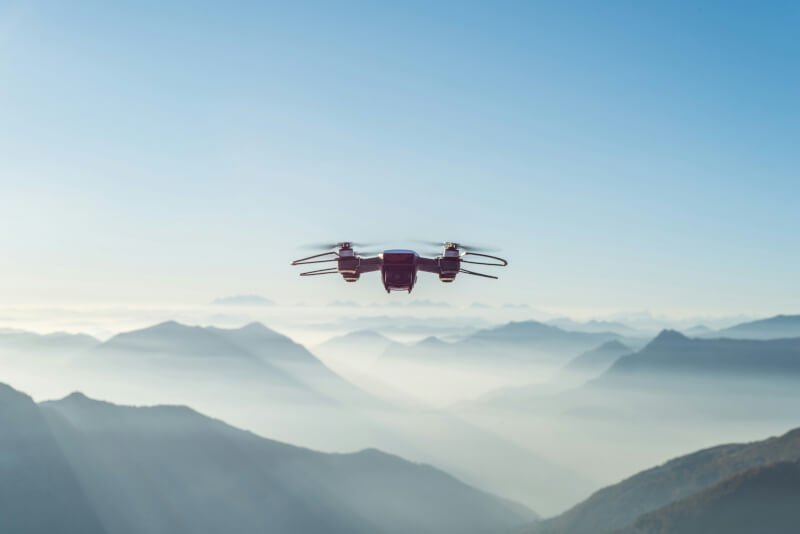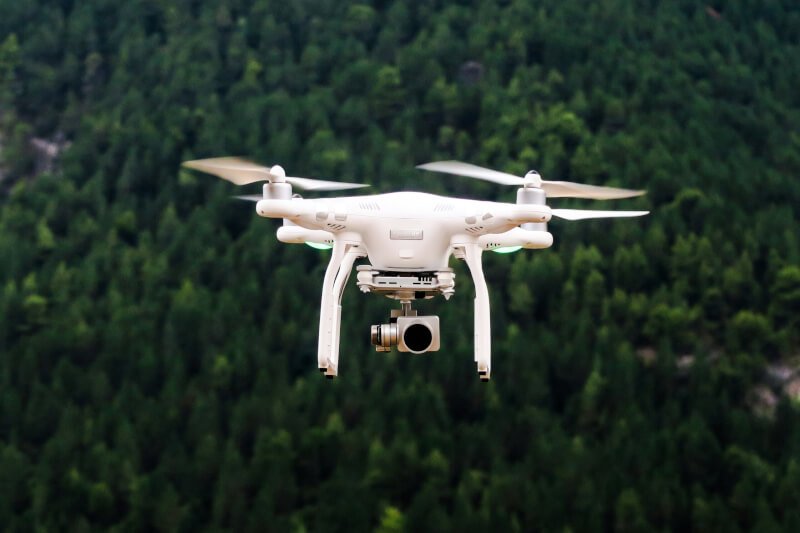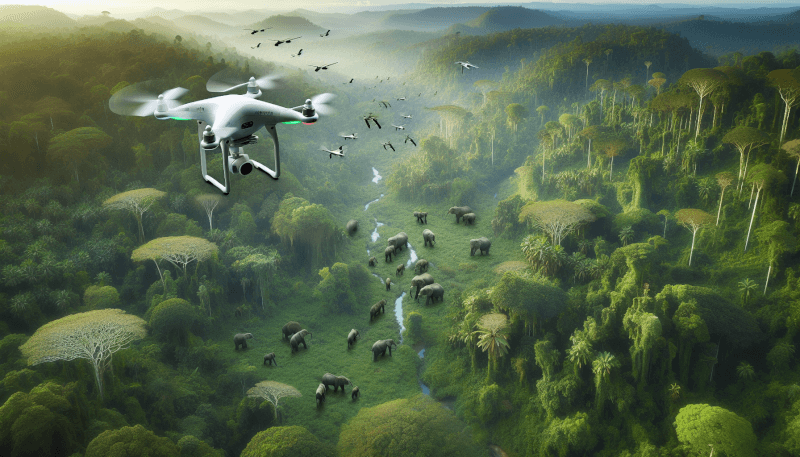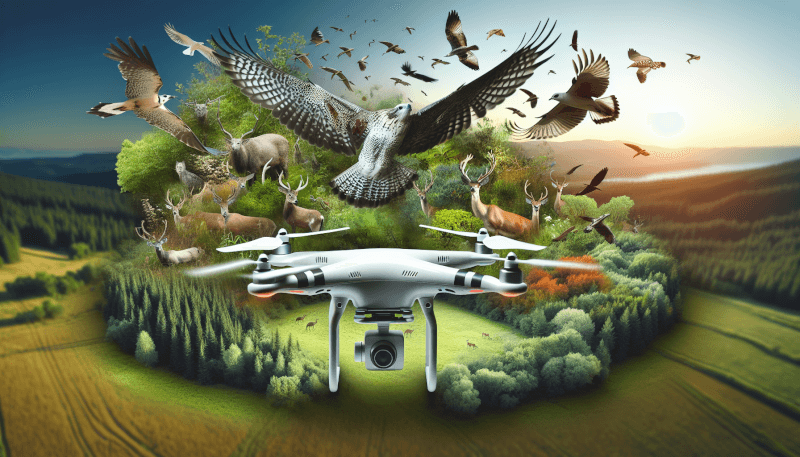Ready to take your wildlife monitoring and research to new heights? Look no further than this beginner’s guide to using drones for all your needs. Drones offer a unique and efficient way to observe wildlife, gather data, and contribute to important research. With their ability to navigate hard-to-reach areas and capture high-resolution images and videos, drones are revolutionizing the field of wildlife monitoring. Whether you’re a curious hobbyist or a dedicated scientist, this guide will equip you with the knowledge and skills necessary to get started in using drones for your wildlife studies. So grab your remote control and let’s soar into the world of aerial exploration!
Understanding Drones
What are Drones?
Drones, also known as unmanned aerial vehicles (UAVs), are remote-controlled aircraft that have gained immense popularity in recent years. These small aircraft are equipped with cameras and sensors that allow them to capture aerial images and collect data from various perspectives. Drones have proven to be highly useful in wildlife monitoring and research, as they provide an efficient and non-invasive way to study and observe animals in their natural habitats.
Importance of Drones in Wildlife Monitoring and Research
Drones have revolutionized the field of wildlife monitoring and research by providing researchers and conservationists with valuable tools to study and understand animal behavior, habitat conditions, and population dynamics. Traditional methods such as ground surveys and manned flights are often time-consuming, expensive, and can disturb the animals being studied. Drones, on the other hand, offer a cost-effective and less intrusive option for data collection, enabling researchers to gather information on wildlife populations, track migration patterns, monitor the health of ecosystems, and identify potential conservation threats.
Types of Drones
There are various types of drones available in the market today, each designed for specific purposes and budgets. Consumer-grade drones, such as the DJI Phantom series, are an affordable option for beginners, offering features like high-definition cameras, stable flight control, and user-friendly interfaces. Professional-grade drones, like the DJI Inspire series, are built for more demanding applications and usually come with advanced camera systems, longer flight times, and enhanced stability. Custom-built drones, tailored to specific research needs, offer the flexibility to choose different components like cameras, sensors, and batteries to achieve specific research objectives. It is important to choose a drone that suits your research requirements and budget.
Key Features of Wildlife Monitoring Drones
When considering a drone for wildlife monitoring and research, there are several key features to look out for. Firstly, flight time is crucial as it determines how long the drone can stay in the air and gather data. Longer flight times allow for more extensive data collection without the need for frequent battery changes. Stability and maneuverability are also important, especially when flying in challenging environments or capturing accurate aerial images. Look for drones with advanced stabilization systems, GPS capabilities, and obstacle avoidance sensors to ensure smooth flights and precise data collection. Lastly, ease of use and compatibility with software for data analysis and post-processing are features worth considering, as they can save time and effort in the research process.
Legal Considerations
Registering and Obtaining Permits
Before deploying a drone for wildlife monitoring and research, it is essential to comply with legal requirements. Many countries have specific regulations governing the use of drones, including registration and obtaining permits. Registration involves providing basic information about yourself and your drone to the relevant authorities. This helps ensure accountability and aids in the identification of responsible drone operators. Additionally, obtaining permits may be necessary for specific research activities, especially if flying in protected areas or using certain drone capabilities. Familiarize yourself with the local regulations and obtain the necessary permits to operate your drone legally and responsibly.
Understanding Aviation Laws and Regulations
In addition to drone-specific regulations, it is crucial to have a good understanding of aviation laws and regulations in your country. This knowledge will help you operate your drone safely and within the legal framework. Familiarize yourself with airspace classifications, restricted zones, and flight restrictions to avoid inadvertently violating any laws. Respect for aviation rules ensures the safety of other airspace users and prevents potential conflicts or accidents. Be aware of altitude limits, flight over populated areas, and the requirement for line of sight when operating a drone. Ignorance of aviation laws can lead to legal consequences and jeopardize the success of your research endeavors.
Privacy and Ethical Concerns
Privacy and ethical considerations should be at the forefront of any drone operation, especially when collecting data in wildlife and conservation studies. Ensure that your research methodology respects the privacy of individuals and minimizes any potential harm to wildlife. Seek informed consent when necessary and avoid intrusive behaviors that could disturb or stress animals in their natural habitats. It is important to conduct research in an ethical manner, adhering to any ethical guidelines or codes of conduct established by relevant institutions or organizations. Be considerate of local communities and their concerns, and engage in open communication to address and mitigate any potential conflicts or negative impacts.

Selecting the Right Drone
Budget and Cost Factors
When selecting a drone for wildlife monitoring and research, it is important to consider your budget and cost factors. Drones range in price from a few hundred to several thousand dollars, depending on the features and capabilities they offer. Consider the investment as a long-term one, taking into account not only the initial cost of the drone but also maintenance, accessories, and potential upgrades. Assess your research requirements and budget constraints to determine the best option for your needs. Keep in mind that while higher-end drones may have advanced features, they may not always be necessary for your specific research objectives. Striking a balance between functionality and cost-effectiveness is key when selecting the right drone.
Choosing the Right Drone Model
With a wide range of drone models available in the market, it can be overwhelming to choose the right one for your wildlife monitoring and research efforts. Begin by evaluating the specific features and capabilities required for your study. Consider factors such as flight time, stability, camera specifications, payload capacity, and data transmission capabilities. Identify the functions that are critical for your research objectives and prioritize those when evaluating potential drone models. Read reviews, seek recommendations from experts, and consult with experienced drone users to gather insights and make an informed decision. Focus on reliability, durability, and ease of use to ensure a smooth and successful research experience.
Considerations for Camera and Sensor Specifications
The camera and sensor specifications of your drone are crucial aspects to consider when selecting the right equipment for wildlife monitoring and research. High-resolution cameras are essential for capturing detailed images and videos of wildlife and their habitats. Look for drones that offer adjustable camera angles, zoom capabilities, and the ability to shoot in different lighting conditions. Additionally, consider the integration of sensors like thermal imaging, LiDAR, or multispectral sensors, depending on the specific research objectives. These sensors can provide valuable data on animal behaviors, vegetation health, and habitat mapping. Assess the compatibility of cameras and sensors with your chosen drone model, as well as their ability to capture the necessary data for your research needs.
Preparing for a Drone Mission
Identifying the Objective and Study Area
Before embarking on a drone mission for wildlife monitoring and research, it is important to clearly define your objectives and study area. Determine the specific research questions you aim to address and the data you need to collect. This will guide your flight planning, data capture, and analysis processes. Take into account the habitat, species, or phenomena you are studying and tailor your approach accordingly. Identify any potential limitations or challenges in the study area that may affect drone operations or data collection. A well-defined objective and study area will streamline your research efforts and ensure that you make the most of your drone missions.
Acquiring Necessary Permissions
Depending on your research location and objectives, you may need to acquire additional permissions or approvals. Certain areas, such as national parks or protected wildlife reserves, may require specific permits or agreements to conduct research activities. Check with local authorities, landowners, or relevant organizations to obtain the necessary permissions and ensure that your research adheres to any guidelines or protocols established for the area. In some cases, it may be beneficial to collaborate with local communities, researchers, or experts who can provide support and guidance during your drone missions. Building these partnerships and acquiring the necessary permissions will help facilitate a successful and collaborative research experience.
Planning the Flight and Research Protocol
Once you have identified your objective and study area and obtained the necessary permissions, it is time to plan your flight and research protocol. Consider factors such as weather conditions, time of day, and seasonal variations that may affect the success of your drone mission. Create a flight plan that outlines the specific areas to be surveyed, flight routes, and altitudes to ensure efficient and comprehensive data collection. Develop a research protocol that outlines the data capture methods, the frequency of flights, and any specific procedures or criteria to be followed during the research. This level of planning and documentation will help ensure consistency, accuracy, and repeatability in your data collection and analysis processes.

Drone Flying Techniques for Wildlife Monitoring
Understanding Flight Modes
To effectively monitor wildlife using drones, it is essential to understand the different flight modes and their applications. Most drones offer flight modes such as GPS mode, altitude hold mode, and manual mode, each serving a specific purpose. GPS mode allows the drone to lock onto satellites, providing stable flight and position hold capabilities. Altitude hold mode enables the drone to maintain a specific height relative to the ground, making it useful for capturing consistent high-quality images or videos. Manual mode provides full control of the drone’s movement, allowing for precise maneuvers during data collection. Familiarize yourself with these different flight modes and practice in a controlled environment before venturing into wildlife monitoring missions.
Mastering Takeoff and Landing
Proper takeoff and landing techniques are essential for successful drone operations and wildlife monitoring. Begin by finding a suitable takeoff and landing area, ensuring it is free of any obstacles or hazards. Calibrate your drone’s compass and ensure the GPS signal is strong before taking off. Gradually increase throttle and allow the drone to hover at a safe altitude. Monitor the surroundings for any potential risks, such as obstacles or animals in the vicinity. When it is time to land, carefully descend the drone, ensuring a controlled and stable landing. Practicing these takeoff and landing techniques regularly will help minimize the risk of accidents and ensure the safety of your drone and the wildlife being monitored.
Controlling Altitude, Speed, and Direction
Maintaining control over altitude, speed, and direction is crucial for effective wildlife monitoring using drones. It is important to adjust these parameters based on the specific research objectives and the behaviors of the animals being studied. Different species may have different sensitivities to drones, so it might be necessary to fly at higher altitudes or slower speeds to minimize disturbance. Take into consideration wind conditions and adjust your flight parameters accordingly to achieve stable and reliable data collection. Adhere to recommended flight distances to maintain a safe distance from the wildlife, allowing for accurate observations without impeding their natural behaviors. Practice controlling altitude, speed, and direction in different scenarios to become proficient in adapting to various field conditions.
Camera and Data Capture Techniques
Optimizing Camera Settings
To capture high-quality images and videos for wildlife monitoring and research, it is essential to optimize the camera settings on your drone. Start by selecting the appropriate shooting mode for your research needs, such as manual, automatic, or custom settings. Adjust the ISO, shutter speed, and aperture to achieve proper exposure and sharpness. Dial in the white balance to ensure accurate color representation. Take advantage of available camera features, such as burst mode or time-lapse, to capture a series of images or document changes over time. Experiment with different camera settings and conduct test flights before starting your research to determine the optimal configuration for your study.
Capturing High-Quality Images and Videos
When it comes to capturing high-quality images and videos of wildlife, proper technique plays a significant role in achieving accurate and valuable results. Ensure that your drone is stable and properly positioned before initiating a capture. Fly slowly and steadily, allowing the camera to focus and capture sharp images. Consider camera angles and perspectives to capture unique viewpoints or specific behavioral patterns. Avoid sudden movements or jerky maneuvers that may result in blurred or unusable footage. Maximize the capabilities of your drone’s camera, such as zoom or pan features, to highlight specific details or behaviors. Practice capturing images and videos under different conditions to enhance your skills and produce exceptional visuals for analysis and interpretation.
Data Storage and Organization
Proper data storage and organization are crucial for efficient and effective wildlife monitoring and research. Develop a systematic approach to file naming and organization to facilitate easy retrieval and analysis of data. Create a hierarchical folder structure that categorizes data based on factors such as study area, date, species, or research objectives. Backup your data regularly to secure storage devices or cloud-based platforms to minimize the risk of data loss or corruption. It is also important to keep detailed records of flights, camera settings, and any other relevant information that may contribute to the interpretation and analysis of the collected data. Sound data management practices will streamline your research workflow and allow for seamless collaboration or future reference.

Analyzing and Interpreting Drone Data
Feature Extraction and Object Detection
Analyzing drone data for wildlife monitoring and research often involves extracting features and detecting objects of interest. Depending on the research objectives, various techniques and software tools can aid in this process. Apply image processing algorithms to extract features such as animal detection, vegetation indices, or land cover classification. Utilize machine learning approaches for object detection or species identification based on patterns or training datasets. These analysis techniques enable the extraction of valuable information from the collected data, providing insights into animal behavior, habitat conditions, or population dynamics. Regularly update your analysis methods and algorithms to incorporate advancements in image processing and machine learning for accurate and efficient data interpretation.
Geospatial Analysis
Geospatial analysis plays a vital role in wildlife monitoring and research, allowing for the integration of drone data with geographic information systems (GIS) and spatial modeling techniques. By georeferencing aerial images or point cloud data captured by drones, researchers can spatially analyze and visualize patterns, relationships, and changes in natural habitats. Conduct landscape-level analysis, such as habitat fragmentation assessment, vegetation mapping, or spatial-temporal analysis of animal movements. Tools such as remote sensing software or GIS platforms can facilitate these geospatial analyses and aid in the identification of hotspots or critical areas for conservation efforts. Develop expertise in geospatial analysis techniques to fully utilize the potential of your drone data for wildlife research purposes.
Data Visualization and Interpretation
Data visualization and interpretation are essential steps in making sense of the collected drone data and communicating research findings effectively. Visualize your data using graphical representations, maps, or interactive dashboards to highlight patterns, trends, or anomalies in the collected information. Use appropriate visualization techniques, such as heatmaps or time-series plots, to showcase seasonality, density, or movement patterns of wildlife populations. Combine different data layers or integrate data from multiple drone missions to provide a comprehensive understanding of the study area. Interpret the visualized data in the context of your research objectives and scientific knowledge, drawing meaningful conclusions and proposing further hypotheses or research directions. Develop compelling visualizations that can easily convey the significance and implications of your research findings to stakeholders, policymakers, or the general public.
Addressing Safety and Risk Mitigation
Pre-flight Safety Checks
Ensuring the safety of your drone operations is paramount to protect your equipment, the wildlife, and the surrounding environment. Before every flight, perform pre-flight safety checks to verify the condition of your drone and its components. Inspect the propellers, motors, and frame for any damage or wear. Check the battery levels and secure all connectors. Verify the functionality of the GPS and other flight systems. Calibrate the compass and perform a test flight to assess the stability and responsiveness of the drone. Always follow the manufacturer’s instructions and perform any required firmware updates or maintenance. Consistent pre-flight safety checks minimize the risk of accidents and contribute to the overall success of your wildlife monitoring and research endeavors.
Dealing with Unexpected Situations
Despite meticulous planning and preparation, unexpected situations may arise during drone missions. It is important to be prepared and capable of addressing these incidents effectively. Develop contingency plans for adverse weather conditions, equipment failure, or unpredictable wildlife behaviors. Carry spare batteries, propellers, and other critical components to handle on-site repairs or replacements. Constantly monitor your drone’s flight parameters and performance during missions to anticipate any issues or abnormal behavior. Familiarize yourself with emergency procedures, such as initiating a return-to-home function, in case of an unforeseen event. Maintaining composure and responding swiftly to unexpected situations will help mitigate risks and ensure the safety of your drone and the wildlife being monitored.
Emergency Procedures and Risk Mitigation
During drone operations for wildlife monitoring, it is essential to have well-defined emergency procedures and risk mitigation strategies in place. Identify potential risks and hazards associated with your operating environment, such as wildlife attacks, unpredictable weather, or technical failures. Develop protocols to minimize these risks and mitigate their impact on your drone missions. Establish communication channels or emergency contact information to seek assistance if needed. Consider the use of safety equipment like visibility vests, first aid kits, or even drone parachutes for added safety measures. Regularly review and update your emergency procedures based on feedback, lessons learned, or changes in your research environment. Proactive risk management ensures the welfare of all stakeholders involved and maximizes the success of your wildlife monitoring and research efforts.

Collaboration and Data Sharing
Working with Local Communities and Experts
Collaborating with local communities and experts is crucial for effective wildlife monitoring and research using drones. Local communities often possess valuable knowledge and insights about the study area, species behaviors, or conservation challenges, which can enhance the outcome of your research. Engage in open and respectful communication with community members, landowners, or indigenous groups to foster collaborative relationships. Seek their input and involvement in the research process, ensuring that their perspectives and concerns are addressed. Collaborate with experts from relevant fields, such as ecologists, wildlife biologists, or drone specialists, who can provide guidance and support with data analysis, interpretation, or technical aspects of drone operations. Building strong partnerships maximizes the impact and success of your wildlife monitoring and research initiatives.
Secure Data Sharing Protocols
Data sharing is an integral part of successful wildlife monitoring and research using drones. Establish secure data sharing protocols to protect sensitive information and ensure responsible data sharing practices. Identify the level of data confidentiality required and implement appropriate measures to safeguard privacy and prevent unauthorized access. Consider using encryption, secure file transfer protocols, or data anonymization techniques when sharing sensitive data. Share data with relevant stakeholders, such as governmental agencies, research institutions, or conservation organizations, to contribute to broader conservation efforts. Openly share findings and data visualizations with the scientific community through publications or conferences to promote collaboration and scientific progress. Adhering to ethical data sharing practices will facilitate transparency, collaboration, and the advancement of wildlife monitoring and research.
Contributing to Conservation Efforts
Using drones for wildlife monitoring and research provides an opportunity to actively contribute to conservation efforts. The data collected can assist in identifying important habitats, tracking population dynamics, or detecting potential threats to wildlife and their habitats. Collaborate with conservation organizations or governmental agencies to align your research objectives with ongoing conservation initiatives. Share your findings and insights with these entities, contributing to evidence-based decision-making processes and the development of effective conservation strategies. Actively participate in conservation awareness campaigns, educating the public about the importance of protecting biodiversity and the role of drones in wildlife monitoring. By actively engaging in conservation efforts, you can help drive positive change and contribute to the long-term preservation of our natural ecosystems.
Future Trends and Innovations in Drone Technology
Advancements in AI and Machine Learning
The future of drone technology in wildlife monitoring and research holds exciting advancements in the field of artificial intelligence (AI) and machine learning. AI algorithms can efficiently process large datasets collected by drones, enabling real-time identification of species, automated analysis of behavior patterns, or early detection of environmental changes. Machine learning algorithms can continuously improve their accuracy and efficiency through adaptive learning, enhancing data analysis and interpretation capabilities. This integration of AI and machine learning with drone technology has the potential to revolutionize the field, allowing researchers to gather more precise and valuable insights from their drone-collected data.
Integration of Sensors and AI for Real-time Monitoring
The integration of different sensors with drones, coupled with AI capabilities, offers immense potential for real-time monitoring and analysis. Sensors like thermal imaging cameras, LiDAR, or multispectral sensors can provide valuable data on animal health, habitat conditions, or even detect illegal activities such as poaching. By combining sensor data with AI algorithms, drones can analyze and interpret this information in real time, providing instant feedback and alerts to researchers on site or even remote locations. Real-time monitoring enables faster response times, efficient decision-making, and improved conservation efforts, ensuring the timely protection of wildlife and their habitats.
Emerging Drone Applications in Wildlife Research
The future of drone technology in wildlife monitoring and research is poised for even greater innovation, with emerging applications that further expand the capabilities and possibilities. Drone swarms, consisting of multiple drones operating together, can enable efficient and widespread data collection, covering larger areas and providing a more comprehensive understanding of wildlife populations and behaviors. Automated sampling techniques, such as trap door mechanisms or remote-sensing-triggered capture devices, can enhance the efficiency of data collection by autonomously capturing specific samples or recordings. Integration with other technological advancements, such as satellite communication systems or Internet of Things (IoT) devices, opens up new avenues for collaborative research and monitoring in remote or inaccessible locations. The future holds immense potential for further advancements and applications of drone technology in wildlife research, continuously pushing the boundaries of what is possible.
In conclusion, drones have revolutionized the field of wildlife monitoring and research, providing researchers with incredible tools to study and understand animal behavior, habitat conditions, and population dynamics. By selecting the right drone, understanding legal considerations, mastering drone flying techniques, and employing effective camera and data capture techniques, researchers can efficiently collect valuable data for analysis and interpretation. Analyzing and interpreting drone data, addressing safety and risk mitigation, collaborating with local communities and experts, and contributing to conservation efforts further enhance the impact and success of wildlife monitoring initiatives. As we look towards the future, the integration of AI, machine learning, and emerging technologies promises even greater advancements and possibilities for drone technology in wildlife research. With continued innovation and responsible usage, drones have the potential to contribute significantly to the conservation and preservation of our natural ecosystems.



